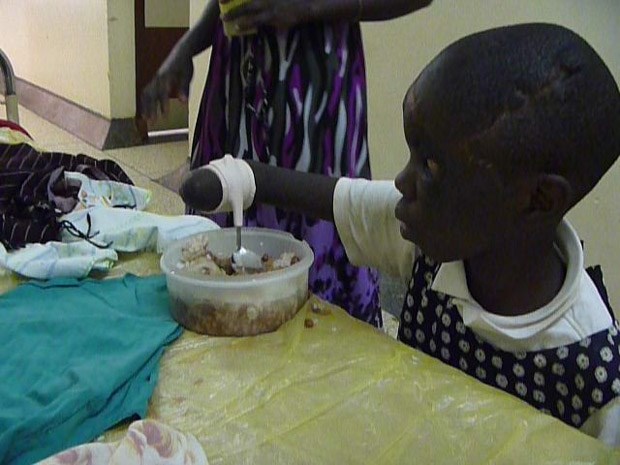"This is the sort of stuff they don't have in Uganda," Joanne Smith says, as she wraps a heated sheet of black plastic around her thumb. Smith is a hand therapist, and this is the sort of thing she makes to help people's hands heal correctly after a burn or injury.
Uganda is far from her home office atop Capitol Hill, but the memories from a recent trip are still fresh as she sits down at her computer and begins flipping through photos. Smith spent two weeks in Kampala, Uganda, sharing her skills at Mulago, the country's largest hospital.
The images look like they're from a medical text of horrors: burn scars growing like sinewy roots up a dark shoulder, a massive chunk of flesh missing from a forearm, fingers burnt to the bones of a small child who was electrocuted. These are just some of the horrific injuries she saw.
"The poverty is incredible," she says.
Smith was invited to Uganda by local surgeons, Canadian colleagues of hers, to help share her skills with hospital staff in Kampala. The surgeons were volunteering with USTOP - Uganda Sustainable Trauma Orthopaedic Program, and were looking into establishing a plastic surgery residency program at the hospital.
Smith left for Uganda in late October, with supplies packed, and spent two weeks there sharing her expertise. As a hand therapist, she fashions a lot of assistive devices and splints to help people with hand injuries or burns once they've been attended to by doctors and surgeons. She also teaches patients exercises to help them recover after surgery.
Flipping through the pictures on her computer, Smith points out some daily hazards in Uganda that bring people to hospital. Burns are frequent, as people cook hot food in open areas, sometimes where children play. Mosquito nets catching on fire from candles is common. So is the phenomenon of throwing acid in the face of a partner suspected of infidelity. Smith said it's mostly women who come in with these burns, but there are men too, and measures are in place to try to make it more difficult to buy battery acid, to help reduce the number of attacks. All this she explains while flipping through images of women with faces burned off, noses missing, skin shriveled.
Supplies in Uganda are scarce, and therapists often make due with what's available. While Smith works with leather and plastic, her Ugandan counterparts may use papier-mâché, cassava flour, cardboard and old magazines. (Magazines are hard to come by and their glossy images are reserved for the top layer of the splint, to try and make it cosmetically attractive, and therefore more valued and used by the person who wears it.)
"The therapist tries to make something out of cardboard to keep an elbow straight, which just isn't strong enough," she says.
Besides the woefully inadequate supplies, sanitary at the hospital is also lacking, Smith points out. There are sinks without soap or towels, or sometimes without faucets. Smith carried her own hand sanitizer.
A typical problem with burns is the scarred skin thickens and contracts, contorting the body into unnatural positions, which can lead to permanent deformities that can only be corrected by surgery. Smith can help after the operation by setting the hands and fingers right, so they can heal in the correct position. For instance, Smith made splints in the operating room for a toddler, whose arm was surgically corrected after a burn left him unable to lift his arm.
But the case closest to her heart is Olivia, she says, pausing at a picture of a seven-year-old girl, with a shaved head in a lime green dress covered with red hearts.
Olivia was in a motorcycle accident and is missing her right arm and her left hand. After the accident, she couldn't close her left eye and had come to the hospital for surgery.
"We happened to see her and thought, 'How on earth can she do anything for herself?'" Smith says. "And she doesn't. Her mother does everything for her."
The hand therapists pulled Olivia aside, and Smith made a band with a spoon connected, to attach to her arm stump. Olivia was able to feed herself for the first time in nine or 10 months.
"Her mother was so excited, she said, 'What about her writing so she can go to school?'"
Smith then tasked Richard Odch, the hospital's only burn unit occupational therapist, with solving the problem, now hopefully inspired by the device she had fashioned.
"He came up with this idea, which is just wonderful," Smith said. Odch created a plastic and Velcro device with a pen attached that could be strapped to Olivia's arm, enabling the girl to write.
After two weeks at the Mulago hospital, Smith returned to the comfort of her Capitol Hill home, with a stunning view of Burrard Inlet. There, she treats people through a home-based practice when she's not working in a private physiotherapy clinic. She's still available to help Odch at Mulago, and he knows he can contact her for information or advice.
One thing Smith had to be cognizant of was the outsider imposing foreign values dynamic.
"What you don't want is a person coming from a Western culture with ideas (of what) the locals need," she says. "You've got to figure out what's valuable to them and not decide what's valuable."
When asked if she learned anything, she says she is reminded at how incredibly fortunate we are.
"Look what I have here," she says. "I can provide the best quality of care . yet for them, the expectations are very different. They continue and manage life without the things we have. We live a very privileged existence.
"If we have knowledge that can make a significant number of people by sharing our knowledge, we can improve the quality of life for a lot of other people," she says.



